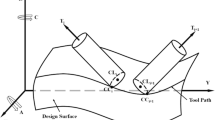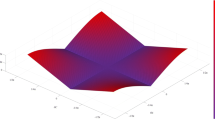Abstract
End milling is widely applied in high-speed machining (HSM), and the tool orientation sequence not only influences on the tool interference but also on the machining quality. The abrupt change of tool orientation may cause over-cut which could scrap the workpiece. There has been a relatively vast class of tool path optimizing method that could decrease the inclination angle along the machining track, but the irregularity point of the machine movement process could not be avoided. This paper describes a tool orientation smoothing method based on the discrete domain of feasible orientations. Firstly, the mapping relation of tool inclination and rotation angles of CNC machine tool rotary axes is formed. Secondly, the cost function and the boundary conditions are formed based on the machine tool distribution. Thirdly, the discrete domain of feasible orientation (DDFO) model is formed by sampling the feasible orientations at each point along the tool path. Finally, the Dijkastra method is applied to find the shortest path in DDFO model and the initial tool orientation sequence is smoothened. And the simulation experiments are implemented to prove the validity of the method proposed.
Similar content being viewed by others
Change history
20 December 2017
The authors have decided to update the reference list of the above-mentioned article and the corresponding contents in Section 3.
References
Marciniak K (1987) Influence of surface shape on admissible tool positions in 5-axis face milling. J Comput Aided Des 19(5):233–236
Jensen CG, Anderson DC (1993) Accurate tool placement and orientation for finish surface machining. J Des Manuf 3:251–261
Rao N, Ismail F, Bedi S (1997) Tool path planning for five-axis machining using the principal axis method. Int J Mach Tools Manuf 37(7):1025–1040
Morisige K, Kase K, Takeuchi Y (1996) Tool path generation using C-space for 5-Axis control machining. J Jpn Soc Precis Eng 62(1):1783–1787
Wang N, Tang K (2007) Automatic generation of gouge-free and angular-velocity-compliant five-axis toolpath. Comput Aided Des 39(10):841–852
Luo M, Wu BH, Li S, Zhang DH (2009) Five-axis tool orientation optimization based on kinematical method. J Mech Eng 45(9):158–163
Affouard A, Duc E, Lartigue C et al (2004) Avoiding 5-axis singularities using tool path deformation. Int J Mach Tools Manuf 44(4):415–425
Sørby K (2007) Inverse kinematics of five-axis machines near singular configurations. Int J Mach Tools Manuf 47(2):299–306
Munlin M, Makhanov SS, Bohez ELJ (2004) Optimization of rotations of a five-axis milling machine near stationary points. Comput Aided Des 36(12):1117–1128
She CH, Huang ZT (2008) Postprocessor development of a five-axis machine tool with nutating head and table configuration. Int J Adv Manuf Technol 38(7):728–740
Anotaipaiboon W, Makhanov SS, Bohez ELJ (2006) Optimal setup for five-axis machining. Int J Mach Tools Manuf 46(9):964–977
Pessoles X, Landon Y, Segonds S et al (2013) Optimisation of workpiece setup for continuous five-axis milling: application to a five-axis BC type machining centre. Int J Adv Manuf Technol 65(1–4):67–79
Hu P, Tang K, Lee CH (2013) Global obstacle avoidance and minimum workpiece setups in five-axis machining[J]. Comput Aided Des 45(10):1222–1237
Lin Z, Fu J, Shen H et al (2014) On the workpiece setup optimization for five-axis machining with RTCP function. Int J Adv Manuf Technol 74(1–4):187–197
Kim T, Sarma SE (2002) Toolpath generation along directions ofmaximum kinematic performance: a first cut at machine-optimalpaths. Comput Aided Des 34(6):453–468
Castagnetti C, Duc E, Ray P (2008) The domain of admissible orientation concept: a new method for five-axis tool path optimisation. Comput Aided Des 40(9):938–950
Lavernhe S, Tournier C, Lartigue C (2008) Optimization of 5-axishigh-speed machining using a surface based approach. Comput Aided Des 40(10–11):1015–1023
Barakchi Fard M, Feng HY (2009) Effect of tool tilt angle onmachining strip width in five-axis flat-end milling of free-form surfaces. Int J Adv Manuf Technol 44:211–222
Li LL, Zhang YF, Li HY et al (2010) Generating tool-path with smooth posture change for five-axis sculptured surface machining based on cutter’s accessibility map. Int J Adv Manuf Technol 53(5):699–709
Ho MC, Hwang YR, Hu CH (2003) Five-axis tool orientation smoothing using quaternion interpolation algorithm. Int J Mach Tools Manuf 43(12):1259–1267
Hsieh HT, Chu CH (2013) Improving optimization of tool path planning in 5-axis flank milling using advanced PSO algorithms. Robot Comput Integr Manuf 29(3):3–11
Massart DL, Dijsktra A, Kaufman L (1978) Evaluation and optimization of Labortary methods and analytical procedures. Tech Instrum Anal Chem 1
Yusup N, Zain AM, Hashim SZM (2012) Evolutionary techniques in optimizing machining parameters: review and recent applications (2007–2011). Expert Syst Appl 39(10):9909–9927
Yildiz AR (2013) Cuckoo search algorithm for the selection of optimal machining parameters in milling operations. Int J Adv Manuf Technol 64(1–4):55–61
Yildiz AR (2013) A new hybrid differential evolution algorithm for the selection of optimal machining parameters in milling operations. Appl Soft Comput 13(3):1561–1566
Author information
Authors and Affiliations
Corresponding author
Additional information
A correction to this article is available online at https://doi.org/10.1007/s00170-017-1473-9.
Rights and permissions
About this article
Cite this article
Wang, Q., Feng, Y., Zhang, Z. et al. Tool orientation sequence smoothing method based on the discrete domain of feasible orientations. Int J Adv Manuf Technol 92, 4501–4510 (2017). https://doi.org/10.1007/s00170-017-0506-8
Received:
Accepted:
Published:
Issue Date:
DOI: https://doi.org/10.1007/s00170-017-0506-8




